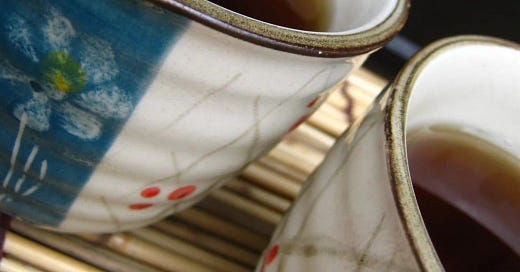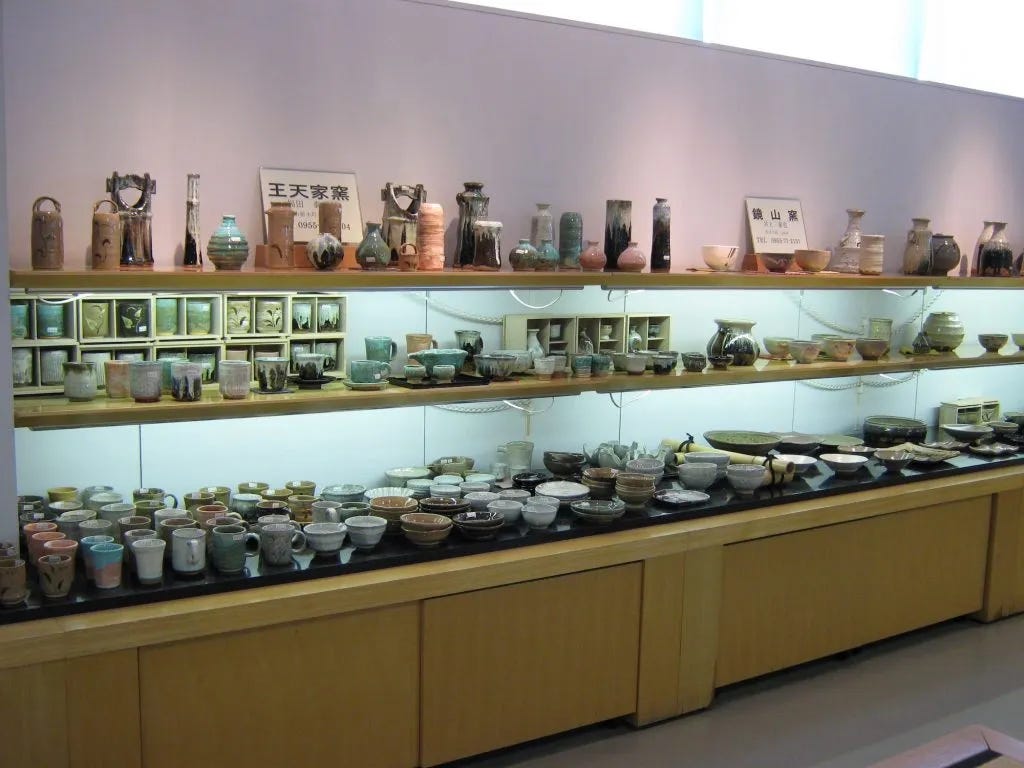If there was one thing I travelled to Japan for, it was the tea and the tea fields. But that plan went a little differently than I had expected, as evidenced by the painstakingly packed tea cups and other ceramic objects that were in my bag home alongside the piles of origami paper and scented sticks with the sakura fragrance. Bowls for the tea ceremony, cups for the plum wine, saucers for sweeteners, I couldn't keep my hands off them. In little boxes, they formed a tetris in my suitcase.
In the Netherlands, I had already been introduced to the process of Raku firing and had used fire and smoke to give some bowls the characteristic sooty crackle in the glaze. But in Japan, I was only really immersed in the tradition of their pottery.
Ceramics, ceramics, ceramics
My interest in ceramics was piqued by a makeshift tea ceremony at the Tea Ceremony Museum in Takayama. It was too hot for a full tea ceremony and so I chose to delve into this beautiful ritual at this museum. Next to the museum was an area where we were given an introduction to the ceremony in a small group.
After a brief explanation, the hostess prepared the matcha tea and poured it for each guest in a separate chawan: the tea bowl. We were each given our bowl and instructions on how to use it properly:
Take it with your right hand, place it on your left, turn the bowl clockwise three times, take three sips, wipe the rim with your fingers, turn back a turn and set it down again neatly with a bow.
All these actions were performed meticulously and silently by us.
What struck me was that the hostess had chosen a special bowl from the collection for everyone. Mine, as I emptied it bit by bit, conjured up a flower. The choice of crockery, like the decoration of the room, is an important part of the ceremony, my hostess told me, so she had chosen this bowl especially for me: she apparently thought I was a budding flower.
This custom is not even that unusual in Japan. If you choose a full menu in a Japanese restaurant, you get a continuous show of beauty. In fact, each dish is served separately, filling your table ‘in no time’ with plates, bowls and platters, each in a different colour, shape or material to suit the dish, season or time of day. If the food looks good and is served on beautiful plates, the Japanese reason, you stimulate the appetite of your guests.
When I had emptied my bowl, I finally got to look at the artwork myself. The handmade ceramics fascinated me: it looked beautiful, it had clearly been made with love and attention and, probably due to ancient knowledge, it lay admirably well in the hand. Each of our bowls had its own particular glaze with accompanying uneven and asymmetrical shapes.
A few days later, on Miyajima Island, I walked past the open door of a pottery shop and could also do nothing but stop and look. Peering through the opening, I marvelled at the almost obsessive attention the potters gave to their work. In the window, I saw tea bowls of all shapes, with decoration of maple leaves and with a dent here and there. I went to investigate and discovered that for osuna-yaki, the pottery made on Miyajima, the sand is excavated at the shrine on the island. But like the choice of sand, the shape of a bowl is also an art in itself. So… which bowl did I want to take home?
Japanese ceramics gripped me and so I ignored the tea fields. I preferred travelling on a slow train to famous pottery centres like Arita or the Oriental Ceramics Museum, rather than trekking from one tea house to another.
In Arita, I also discovered porcelain pottery, exuberantly painted with motifs with clear Chinese influence. But I was still more interested in the simple stoneware for everyday use, glazed or unglazed. The functional shapes and natural colours of the clay, the irregularities in the glaze, the rough surface and the almost randomly created decoration, for me that is truly Japan.
With the highlight being Kintsugi: the repair of pottery objects with a gold-coloured lacquer, whereby the fractures actually enhance the beauty of the object. For me, this perfect imperfection represents the care, attention and appreciation that Japanese have for pottery. After all, in Japan, you buy a ceramic masterpiece for long-term use.
But above all, what the Japanese have taught me with this treatment of pottery is that life consists of a spiritual side, the Wabi, which manifests itself in ceremony, peace and quiet. And a material side, the Sabi, which is mainly governed by imperfection and eternal change. With this Wabi Sabi, accepting the impermanence of everything around us, in the back of my mind, I lovingly and mindfully drink a tea from my own perfect imperfect chawan every time.
With love,
Daphne







